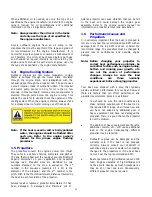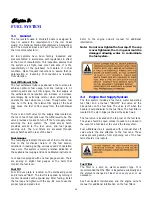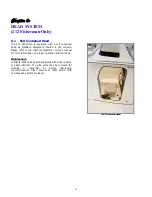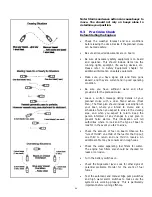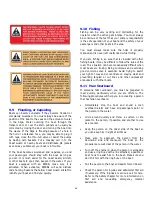
Chapter 8:
SAFETY EQUIPMENT
8.1
General
Your boat has been equipped with safety equipment
designed to enhance the safe operation of the boat and
to meet U.S. Coast Guard safety standards. The Coast
Guard or state, county, and municipal law enforcement
agencies require certain additional accessory safety
equipment on each boat. This equipment varies
according to length and type of boat and type of
propulsion. The accessory equipment typically required
by the Coast Guard is described in this chapter. Some
local laws require additional equipment. It is important
to obtain “Federal Requirements And Safety Tips for
Recreational Boats”, published by the Coast Guard, and
copies of state and local laws, to make sure you have
the required equipment for your boating area.
8.2
Required Safety Equipment
Besides the equipment installed on your boat by
Wellcraft, certain other equipment is required by the
U.S. Coast Guard to help ensure passenger safety. Items
like a sea anchor, working anchor, extra dock lines, flare
pistol, life vests, a line permanently secured to your ring
buoy, etc., could at some time save your passengers’
lives, or save your boat from damage. Refer to the
“Federal Requirements And Safety Tips for Recreational
Boats” pamphlet for more detailed description of the
required equipment. You also can contact the U.S. Coast
Guard Boating Safety Hotline, 800-368-5647, for more
information on boat safety courses and brochures listing
the Federal equipment. Also, check your local and state
regulations.
The Coast Guard Auxiliary offers a “Courtesy
Examination”. This inspection will help ensure that your
boat is equipped with all of the necessary equipment.
The following is a list of the accessory equipment
required on your boat by the U.S. Coast Guard.
Personal Flotation Devices (PFDs)
PFDs must be Coast Guard approved, in good and
serviceable condition, and of appropriate size for the
intended user. Wearable PFDs must be readily
accessible, meaning you must be able to put them on in
a reasonable amount of time in an emergency. Though
not required, the Coast Guard emphasizes that PFDs
should be worn at all times when the vessel is
underway. Throwable devices must be immediately
available for use. All Wellcraft boats must be equipped
with at least one Type I, II or III PFD for each person
on board, plus one throwable device (Type IV)
In addition to the requirements set by the Coast Guard,
individual states may have additional requirements for
children and specific types of recreational activity. Please
visit
www.nasbla.org
for state laws.
Visual Distress Signals
All boats used on coastal waters, the Great lakes,
territorial seas, and those waters connected directly to
them, must be equipped with Coast Guard approved
visual distress signals. These signals are either
Pyrotechnic or Non-Pyrotechnic devices.
Pyrotechnic visual distress signals:
Pyrotechnic visual distress signals must be Coast Guard
approved, in serviceable condition, and readily
accessible. They are marked with a date showing the
service life, which must not have expired. A minimum of
three are required. Some pyrotechnic signals meet both
day and night use requirements. They should be stored
in a cool, dry location. They include:
•
Pyrotechnic red flares, hand held or aerial.
•
Pyrotechnic orange smoke, hand-held or floating
•
Launchers for aerial red meteors or parachute flares
37
Summary of Contents for 180 Sportsman
Page 2: ...2...
Page 4: ...4...
Page 7: ...180 FISHERMAN SPECIFICATIONS 7...
Page 8: ...180 SPORTSMAN SPECIFICATIONS 8...
Page 9: ...202 FISHERMAN SPECIFICATIONS 9...
Page 10: ...212 FISHERMAN SPECIFICATIONS 10...
Page 18: ...18...
Page 39: ...SAFETY LABELS 2601 1124 39...
Page 40: ...180 FISHERMAN 180 SPORTSMAN CAPACITY LABELS 40...
Page 41: ...202 212 FISHERMAN CAPACITY LABELS 41...
Page 61: ...Appendix A SCHEMATICS 180 FISHERMAN INSTRUMENT PANEL 61...
Page 62: ...Appendix A SCHEMATICS 180 SPORTSMAN INSTRUMENT PANEL 62...
Page 63: ...Appendix A SCHEMATICS 202 212 FISHERMAN INSTRUMENT PANEL 63...
Page 68: ...Appendix A SCHEMATICS 180 FISHERMAN 180 SPORTSMAN TRAILER DRAWING 68...
Page 69: ...Appendix A SCHEMATICS 202 212 FISHERMAN TRAILER DRAWING 69...
Page 70: ...Appendix A SCHEMATICS 180 FISHERMAN OVERHEAD LAYOUT 70...
Page 71: ...Appendix A SCHEMATICS 180 SPORTSMAN OVERHEAD LAYOUT 71...
Page 72: ...Appendix A SCHEMATICS 202 FISHERMAN OVERHEAD LAYOUT 72...
Page 73: ...Appendix A SCHEMATICS 212 FISHERMAN OVERHEAD LAYOUT 73...
Page 77: ...MAINTENANCE LOG 77...
Page 78: ...MAINTENANCE LOG 78...
Page 80: ...Appendix D BOAT ACCIDENT REPORT 80...
Page 81: ...81...
Page 87: ...Appendix F TROUBLESHOOTING GUIDE 87...
Page 88: ...TROUBLESHOOTING GUIDE 88...
Page 89: ...TROUBLESHOOTING GUIDE 89...
Page 90: ...TROUBLESHOOTING GUIDE 90...
Page 91: ...TROUBLESHOOTING GUIDE 91...

